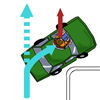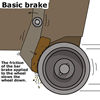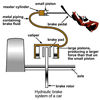Friction is the force of resistance to motion between two surfaces moving over each other. Friction only occurs when movement occurs. Friction will stop motion if the moving force is not strong enough to overcome the contact between the surfaces.
Friction is caused by tiny imperfections or roughness on surfaces that prevent or impede movement. Lubricants such as oil fill these gaps so reducing the effects of friction.

|
Lubrication |
Rub your fingers over your desk top, then over your mouse pad and a few other objects around you. You will notice that your fingers glide more easily over some surfaces than others. You experience friction in everyday situations; sometimes it can be useful and sometimes it can be a problem.
Friction working for you
 When
you stand up and walk friction is an essential aid. There is friction
between your foot or shoe and the ground. Sometimes the friction is high,
like walking on carpet, and sometimes it is low when stepping on shiny
tiles. Stand up and take a couple of paces, noticing what happens. You
will observe that as you raise one foot and move it forward the rear foot
grips the floor. By this method you are able to push against the floor
surface and move forward confidently.
When
you stand up and walk friction is an essential aid. There is friction
between your foot or shoe and the ground. Sometimes the friction is high,
like walking on carpet, and sometimes it is low when stepping on shiny
tiles. Stand up and take a couple of paces, noticing what happens. You
will observe that as you raise one foot and move it forward the rear foot
grips the floor. By this method you are able to push against the floor
surface and move forward confidently.
Now move your computer mouse across the mouse pad. The mouse seems to ride smoothly, but the ball underneath grips the pad and rolls. This movement is then translated into a cursor moving across your screen.
Then there is your car. The tyres grip the road because of friction between the two surfaces and the force of the road on the tyres accelerates the vehicle forward. The wheels try to spin, but friction between the two surfaces forces the car to go forward. You will have been very aware of the importance of friction if you have travelled over ice, or oil, or when it has rained after a long dry spell and there is tyre residue on the road! Under the bonnet, fan belts transfer energy because of friction between rubber and metal. Clutches work by plates coming together under pressure, and friction between the plates making the gear box drive the wheels. Of course, friction is put to good use in braking, where a brake pad is pressed against the disc or drum, slowing the wheels.

|

|

|
Railway engines move by friction between the wheels and the rail. Conveyor belts transport goods using friction between the rollers and the belt. Velcro grips work because of the huge frictional forces between the hooks and rings on the velcro. There are many more examples of the importance of friction in everyday situations.
Friction working against you
Rub your hands together and notice that friction results in a temperature
increase. Friction is sometimes a problem because it can cause a great
deal of wear and tear. You have probably noticed this on clothes and furniture
where there is rubbing, and even the tyres on your car wear because there
is always a small amount of slip when turning corners or sliding on slippery
roads.

|
Friction |
Car engines have closely fitted parts that move quickly. For example, piston rings in a cylinder travel at several thousand revolutions a minute. In this case, the engine would get very hot, and finally seize up, because of friction. That's why it is essential to have oil in the engine to get between the moving parts, reduce friction and lower the overall engine temperature.
A similar situation occurs with metal hinges that squeak. The sound is a caused by vibrations as friction stops the hinge from swinging freely, and again it can be reduced by oil in the parts that touch.
Whenever an object moves through air it experiences friction in the form of air resistance. Air resistance can be both helpful and a hindrance.
 Meteoroids burn up in the atmosphere due to friction between themselves
and the air around them. Thank goodness, because if they did not burn
up, the Earth would be continually peppered with rock from space!
Meteoroids burn up in the atmosphere due to friction between themselves
and the air around them. Thank goodness, because if they did not burn
up, the Earth would be continually peppered with rock from space!
Aeroplanes can be controlled in flight because of air resistance. The balance between the thrust of the engines and drag from air resistance allows the pilot to gain or reduce altitude and speed as well as maneuver in the air. (See Forces in mechanical flight)
 On the down side, the temperature increase caused by friction on
space shuttles as they enter the atmosphere could cook the crew if left
unchecked. The shuttle is covered in smooth ceramic tiles which act as
heat insulators, as well as reducing the air resistance of the craft.
On the down side, the temperature increase caused by friction on
space shuttles as they enter the atmosphere could cook the crew if left
unchecked. The shuttle is covered in smooth ceramic tiles which act as
heat insulators, as well as reducing the air resistance of the craft.
Air resistance causes friction and slows a car, for example, by causing drag. Even when driving along a straight flat road, the car's engine must be kept going to overcome the drag of the air to keep the car moving at a constant speed.
| Copyright owned by the State of Victoria (Department of Education and Early Childhood Development). Used with Permission. |